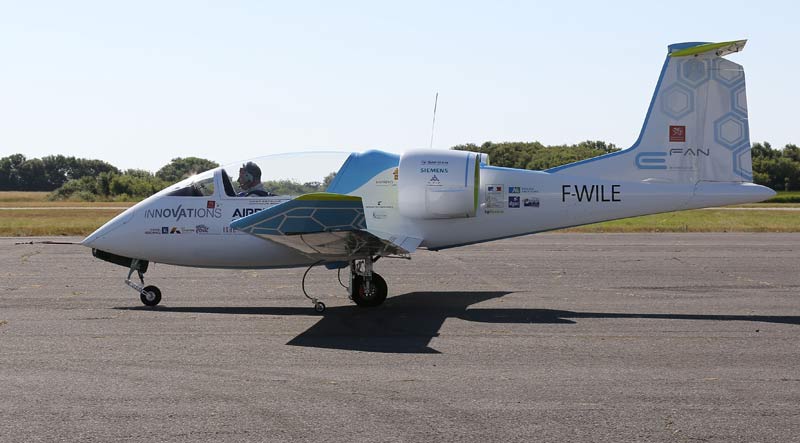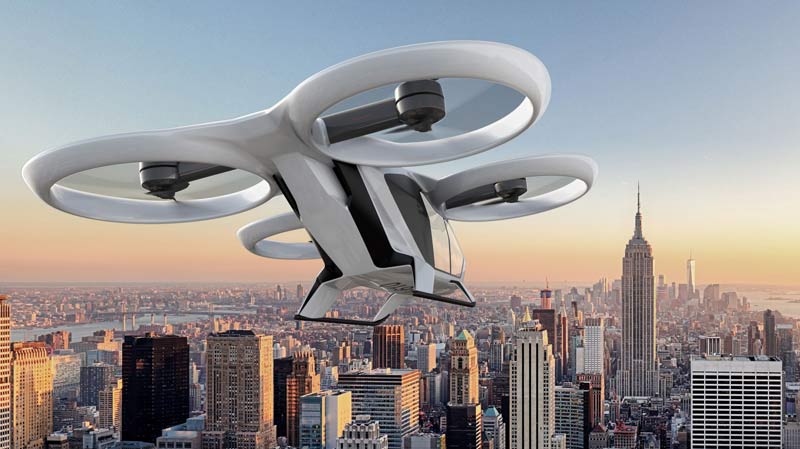Electric-powered airliners aren’t coming any time soon, but Airbus and Boeing see potential.
Elon Musk co-founded Tesla Motors in 2003 to make electric cars, a technology at that time largely ignored by the world’s biggest automakers. Fourteen years later, Tesla’s market capitalisation has surpassed Ford’s and General Motors’. On 9 June this year its market cap zoomed past BMW to make Tesla, for several weeks, the third-most-valuable company in the automotive industry – despite producing fewer than 70,000 electric cars last year, compared with 10 million each by Toyota and Volkswagen.
On the same day, coincidentally, Airbus hosted a news briefing in Toulouse by chief technology officer Paul Eremenko, who revealed more details about the company’s enthusiastic pursuit of electric-powered flight. He compared the coming decade to previous “golden eras” in aerospace innovation, when the industry made leaps in the range and speed of powered flight in the 1920s and 1950s: “I think they will be some of the most exciting years in aerospace engineering work in a half-century and that is the third golden age I’m willing to sign up for.”
A week earlier in Seattle, Boeing vice-president of product development Mike Sinnett offered a similar briefing. On 5 April, Boeing’s HorizonX venture capital arm and JetBlue Technology Ventures partnered to finance Zunum, a Seattle-based start-up aiming to develop an electric aircraft for general aviation and, possibly, a hybrid-electric powered 50-seat regional jet.
As Zunum’s projects move forward, Boeing Commercial Airplanes plans to introduce electric propulsion technology in the unit’s ecoDemonstrator flying testbed programme.

All-electric E-Fan got Airbus off the ground; now it will pursue vertical take-off and landing, and hybrids
Invicta Kent Media/REX/Shutterstock
“In 2021, we are looking at the potential for doing additional work with small electric aeroplanes, with hybrid electric aeroplanes, with small autonomous aeroplanes, all meant to increase our knowledge about autonomy but also to increase our knowledge about all-electric aircraft and hybrid-electric aircraft,” Sinnett told reporters.
The unspoken subject of both presentations was clear: Airbus and Boeing aren’t going to sit back and allow an aerospace version of Tesla to capture the stock market’s affection in 14 years. However, despite rising enthusiasm for electric-powered aircraft ranging from intra-urban flying taxis all the way up to 150-seat airliners, it’s not clear that the world’s largest aerospace manufacturers should be worried.
Alan Epstein, Pratt & Whitney’s vice-president for technology and environment, has emerged as perhaps the most outspoken critic of proposals to develop hybrid-electric propulsion systems to replace gas turbines in aircraft the size of an Airbus A320 or Boeing 737. “My personal view, since I used to be in the battery business somewhat, is that it will take a chemistry discovery worthy of a Nobel prize to give you the energy density you need for a battery-powered commercial aircraft,” Epstein said at a May presentation at the Washington DC chapter of the Royal Aeronautical Society.
To Epstein, an all-electric single-aisle is an absurd notion within a decade, even if makes generous assumptions of improvements in battery technology. The issue comes down to a basic mismatch in the energy density properties of hydrocarbon fuels and lithium ion batteries.
Epstein analysed a 737-sized aircraft and removed the weight of the fuel. He replaced that weight with batteries offering 50% higher energy density than commercially available today. A gas-fuelled 737 can fly nearly 3,000nm, but the battery-powered version lacked enough energy even to take-off. “You can’t really taxi out to the end of the runway and you’re certainly not allowed to lift the nose wheel,” Epstein says.
Battery technology is rapidly improving, however, so Epstein revised his analysis. Instead of only a 50% improvement in energy density, Epstein assumed the 737 would carry a battery load 10 times more powerful than those that exist today. Despite the more generous assumption, this hypothetical 737 would still have limited appeal to airlines expecting transcontinental range.
“If I had 600% improvement in the electrical equipment and factor of 10 in the batteries, I can just get to the point where the aeroplane can take off, circle the field and then land,” Epstein says. “So it looks like a hard thing to do.”
All-electric aircraft are not the only option. Aircraft manufacturers can design a hybrid-electric vehicle, using gas turbines as an electric generator, or for thrust in cruise. Batteries or a fuel cell would be used as an emergency back-up or to augment thrust in take-off and climb. But the hybrid-electric design requires an aircraft to carry redundant propulsion systems, making that part of the aircraft twice as expensive.
“This will double the cost of the propulsion system, which is really good news for United Technologies,” Epstein jokes. “I’m going to assume the aerospace primes aren’t going to absorb this, but pass it on to their customers.”
Epstein further analysed the costs to answer a fundamental question: To offset acquisition and operating costs of a redundant propulsion system, how much more efficient must a hybrid-electric 737 be to lower the airline’s net costs?
“The price of fuel is about $1.56 [in April], then you need a 42% improvement in fuel burn to break even,” Epstein says. “If the fuel goes up to $4 a gallon – certainly something that might happen – then you’ve got to be 20% better in fuel burn to break even.”
Both Eremenko and Sinnett have heard Epstein’s objections to electric propulsion technology and – for the most part – they don’t disagree.
Despite Boeing’s interests in Zunum, Sinnett agrees a hybrid-electric aircraft faces a difficult cost challenge. “A hybrid requires you to double up on equipment,” Sinnett says. “I’m not convinced that that’s the best way to go. However, I understand that there are certain missions where the electric aids you in a period of time where you need it, and then you go into longer-mode operation on a traditional fuel. So I would say the jury is still out and we have got a lot of work to do – but it’s interesting enough for me to think there could be something there.”
Asked about Epstein’s argument, Airbus’s Eremenko also concedes that the P&W executive has a point. But, Eremenko adds, Airbus is still pursuing electric propulsion as a research and technology (R&T) effort – not a long-term product strategy: “Our conclusion is, it’s interesting enough that we should look at it at the level of R&T projects and the level of flight demonstrators.”

CityAirbus electric-powered concept for urban mobility could enter flight testing next year
Airbus
In his presentation, Eremenko outlined an R&T objective to produce a 20MW-class single-aisle-sized demonstrator with a hybrid-electric propulsion system, featuring several advanced features, such as boundary layer ingestion, blown wings and yaw control using differential thrust.
“Let’s be clear: The hybrid power chain today is less efficient than a conventional gas turbine engine because it includes the additional steps of converting to and from electrical energy,” Eremenko says. “For it to make a desirable product we must eke out efficiencies in other areas. For the first time since the jet age… we are really thinking of opening up the design trade space beyond the tube and wing.”
Epstein’s presentation came almost a month earlier, but he seemed to anticipate this possibility. Noting his 20% fuel burn improvement requirement with fuel at $4 a gallon, a hybrid electric propulsion system with blended-wing configuration and other exotic features could compete well against a gas turbine-powered aircraft relying on a conventional tube-and-wing configuration. However, Epstein suggests that the potential efficiency benefits of alternatives to a conventional configuration should not be reliant on electric propulsion. That is, the same benefits would apply to a gas turbine-powered aircraft – where the acquisition cost would be cheaper without the redundancy of a hybrid-electric system.
In contrast to his scepticism about hybrid-electric large aircraft, Epstein is open to the potential benefits of electric-powered small aircraft and even flying cars. One of the key drawbacks of flying-car designs has been the lack of an engine with aviation-grade reliability, and electric power can help mitigate that problem. “It strikes me that the electric propulsion means you could take a not-so reliable engine like an auto engine, have some batteries on there and if the prime engine fails you have enough batteries to let it automatically land safely someplace,” he says.
Interestingly, Airbus and Boeing are also interested in developing small, electric-powered aircraft.
For Boeing, the interest became public only on 5 April, with the announcement of the company’s investment in Zunum. As the investment came from HorizonX, Boeing Commercial Airplanes is not directly involved, according to the corporation organisation chart. HorizonX reports directly to Boeing chief financial officer and executive vice-president Greg Smith. But, as Sinnett explains, BCA is heavily involved in the project: “I work very closely with HorizonX and Zunum. We are providing the technical talent to help and then we are involved in the discussions on the strategy.”
BCA’ focus is on developing and manufacturing products, not exploring potentially disruptive ideas that fall outside the large transport aircraft market segment. Using HorizonX to manage the programme “gives them an ability to explore a marketspace that’s very different from the core BCA mission right now,” Sinnett says.
Airbus’s interests in electric propulsion have been well known for years. The company’s journey started humbly in 2010 with a French home-built aircraft called the Cri-Cri. Airbus replaced two piston engines with four small electric motors and launched a series of flight tests. That was followed with an electric-powered version of the Diamond Aircraft DA36 E-Star motor glider. By 2013, the company was ready to start experimenting with the E-Fan series.
Airbus exhibited three versions of the E-Fan – 1.0, 1.1 and 1.2. But the E-Fan project was abandoned earlier this year, which ended a proposal to launch a pilot training service using a follow-on, electric-powered aircraft.
Instead, Airbus has replaced the E-Fan with a two-track effort for electric-powered aircraft: vertical take-off and landing for urban mobility and fixed-wing for the transport mission. Airbus plans to perform the first hover flight of the Vahanna demonstrator, an all-electric, autonomous, VTOL air taxi with eight motors and tilt-wing. It will be followed into flight testing next year by a series production design called the CityAirbus.
On a separate track, Airbus will continue pursuing the ultimate goal of a hybrid-electric, single-aisle sized aircraft. The next step came with the launch of the E-FanX, flight demonstrator sized as a small commuter jet. “We believe with a strong push we could demo a 2MW flight-weight hybrid electric power system in about three years,” Eremenko says. “We see this as the upper limit of what is attainable with more-or-less conventional power distribution technology without having to master superconductivity or other exotic approaches.”
By using a twin-engined commuter jet, Airbus will be able to replace one or both of the wing-mounted engines with electric motors driven by an integrated turbine generator embedded in the fuselage.
“Of course, the ultimate prize for us is to enable hybrid electric propulsion architecture for a single-aisle aircraft at the scale of the A320 family,” Eremenko says. “I’m reluctant to put a date on such a demonstrator – much less a product. But it’s becoming increasingly clear to us that such an aircraft is not only feasible but very likely desirable.”
Source: Cirium Dashboard





























